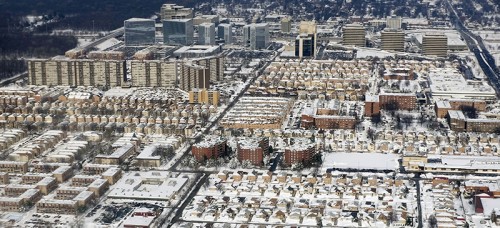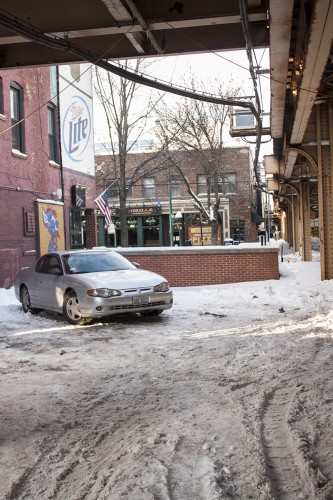
Ask any longtime Chicago resident the two things they most associate with Midwestern winters and they will likely respond with these words:
“Snow and ice.”
A natural consequence of winter weather is that residents are more likely to hunker down in their homes rather than go out for entertainment. However, lost in the snowy sessions of Netflix and hot chocolate is the other side of the question: How do these winter consumer habits bode for businesses?
“January and February are always slower than any other months,” Kaylie Rettig, a bartender at Kincade’s Bar and Grill, said.
Dustin Cardinal, a shift bartender at Kelly’s Pub, agreed with this sentiment. “A lot of people who may make plans ahead of time and say, ‘we’re going to the bar’ end up just staying home after it snows.”
Commonly when discussing the “cost of snow,” people may only consider the literal cost of snow removal — the road salt, the plows and other such costs.
As it really is, however, the cost of snow goes far beyond such immediate factors.
“Weather can have a detrimental effect for many businesses, especially those that depend on walk-in pedestrian traffic,” Terri Lonier, the executive director for DePaul’s Coleman Entrepreneurship Center, said.
“In addition to (lost foot traffic), you have to account for other things,” Cardinal said. “We’re a particular bar that has a parking lot, and when it snows most drivers don’t show. It’s still not completely plowed yet so it’s still tricky for potential customers to come in and out.”
This year’s winter could be comparable to some of the snowier winters of Chicago’s past. Accuweather reported that as of Feb. 8, there have been 27.6 inches of total snowfall this winter. Last year’s winter — which was noted for multiple “polar vortexes” — boasted 44.6 inches of snow over the same period. Both figures are much higher than Chicago’s average snowfall of 19.9 inches over this period.
Particularly this year, however, the economic downturn from adverse weather was sharp for some businesses due to a large snowstorm that occurred during the Super Bowl on Feb. 1.
“I would say that only about 25 percent of the people we expected to show (for the Super Bowl) ended up showing that night. And that’s being generous,” Cardinal said. “Other industry people I know also said that it turned out being an all-around bad night for Chicago bars.”

Although adverse seasonal effects may seem relatively short, these types of effects can impact a business in the long term.
“A lot of businesses, say certain restaurants and boutiques, may not have massive (profit) margins,” Dave Mitria, a manager at barbeque restaurant and bar Barn and Company, said. “So if you have one bad month and you’re down $10,000 to $15,000, you could be chasing that back for three to six months to recover financially. You have to be smart about your business. At the end of the day, you still have to pay taxes and bills and such, as those don’t stop just because there is unfortunate weather.”
The total economic impact of adverse weather can be larger in scale than just its effects on a few individual local businesses. Bruce Watson of DailyFinance.com previously speculated that a snowstorm hitting the major cities of the Northeastern U.S. could possibly create up to $48.8 billion in lost productivity per day. It is important to note, however, that few studies tallying exact macroeconomic costs of blizzards exist.
Aggregate measures reflect the overall impact of the colder months. The U.S. Bureau of Economic Analysis reported that from 2012 to 2014, the first quarter of the year — January to March — always boasted the lowest figures of national consumer spending on goods and services.
These spending figures shrank even lower when excluding energy costs, one of the few commodities to boost in demand in the cold months, for obvious reasons.
In addition to gas and energy companies, delivery services emerge as one of the few benefactors of winter spending patterns. Data provided from Grubhub to CNBC showed that during the recent blizzard in the Northeast, deliveries in New York City for items such as pizza, hot chocolate and bagels doubled, while tips spiked by an average of 8 percent higher than normal.
For most businesses, however, consumer demand drops due to seasonal factors, and they need to adjust their strategies accordingly. In this respect, some local business owners are able to insulate their business from seasonality better than others.
“We kind of layer ourselves with different services, so that in case there is a drastic storm we can ensure some type of business,” Mitria said. “I thought the weather might have affected the Super Bowl more, but people were ordering (catered) wings and ribs for their home parties. We had also sold out on restaurant space due to reservations people previously made. We had set this all in motion prior to that day, so that we didn’t have to rely on walk-in business.”
Other businesses rely on different strengths to get through difficult seasons.
“Our location next to the ‘L’ is a big strength,” Rettig said. “People get off the train from work and, due to our prominent location, there is always some constant amount of pedestrian traffic compared to businesses in other locations.”
Different strategic aspects of the business plan have to account for seasonal changes in customers as well.
“If we were to do a large type of demolition or renovation of the store, you would have to try to do it in a time when you’re not busy, so that you wouldn’t interrupt business too much,” Mitria said. “When we have these types of plans, we would do it right now in February, after the Super Bowl and before St. Patrick’s Day and March Madness.”
“My advice to potential new business owners would be (to) understand your customer, understand when people are more likely to buy your merchandise,” Lonier said. “Some types of businesses may be more vulnerable to such (seasonal) cycles, and it should be understood that seasonal businesses need to open in a time that boosts their early profit.”
Overall, the majority of businesses that are dependent on spontaneous pedestrian business — bars, restaurants and certain boutique stores — are well aware they will face certain unfavorable effects from weather-related consumer habits and prepare themselves for the colder months.
“I think that Chicago business owners understand that winter weather is something that needs to be built into their business model,” Lonier said.

